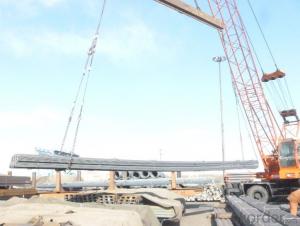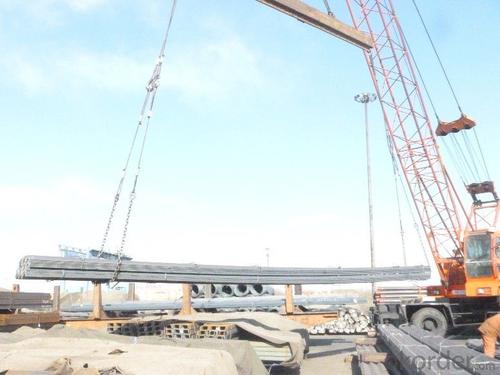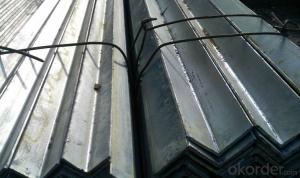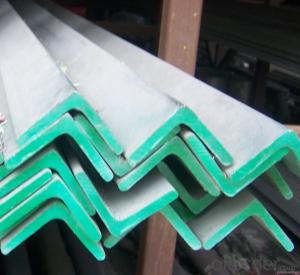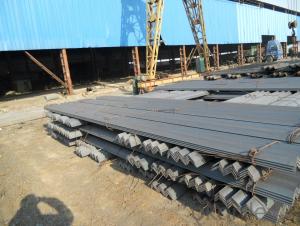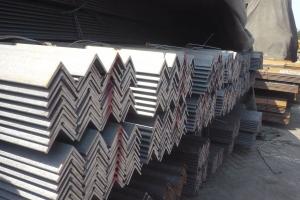Angle steel; steel angle for sale
- Loading Port:
- Shanghai
- Payment Terms:
- TT OR LC
- Min Order Qty:
- 25 m.t.
- Supply Capability:
- 10000 m.t./month
OKorder Service Pledge
OKorder Financial Service
You Might Also Like
Specifications of Angle Steel
1. Invoicing on theoretical weight or actual weight as customer request
2. Length: 6m, 9m, 12m as following table
3. Sizes

Sizes: 25mm-250mm | ||
a*t | ||
25*2.5-4.0 | 70*6.0-9.0 | 130*9.0-15 |
30*2.5-6.6 | 75*6.0-9.0 | 140*10-14 |
36*3.0-5.0 | 80*5.0-10 | 150*10-20 |
38*2.3-6.0 | 90*7.0-10 | 160*10-16 |
40*3.0-5.0 | 100*6.0-12 | 175*12-15 |
45*4.0-6.0 | 110*8.0-10 | 180*12-18 |
50*4.0-6.0 | 120*6.0-15 | 200*14-25 |
60*4.0-8.0 | 125*8.0-14 | 250*25 |
5. Payment terms:
1).100% irrevocable L/C at sight.
2).30% T/T prepaid and the balance against the copy of B/L.
3).30% T/T prepaid and the balance against L/C
6.Material details:
Alloy No | Grade | Element (%) | |||||
C | Mn | S | P | Si | |||
|
|
|
|
|
|
| |
Q235 | B | 0.12—0.20 | 0.3—0.7 | ≤0.045 | ≤0.045 | ≤0.3 | |
|
|
|
|
|
|
| |
Alloy No | Grade | Yielding strength point( Mpa) | |||||
Thickness (mm) | |||||||
≤16 | >16--40 | >40--60 | >60--100 | ||||
≥ | |||||||
|
|
|
|
|
| ||
Q235 | B | 235 | 225 | 215 | 205 | ||
Alloy No | Grade | Tensile strength (Mpa) | Elongation after fracture (%) | ||||
Thickness (mm) | |||||||
| ≤16 | >16--40 | >40--60 | >60--100 | |||
≥ | |||||||
|
|
|
|
|
|
| |
Q235 | B | 375--500 | 26 | 25 | 24 | 23 | |
Usage & Applications of Angle Steel
According to the needs of different structures, Angle can compose to different force support component, and also can be the connections between components. It is widely used in various building structures and engineering structures such as roof beams, bridges, transmission towers, hoisting machinery and transport machinery, ships, industrial furnaces, reaction tower, container frame and warehouse etc.
Packaging & Delivery of Angle Steel
1. Packing: it is nude packed in bundles by steel wire rod
2. Bundle weight: not more than 3.5MT for bulk vessel; less than 3 MT for container load
3. Marks:
Color marking: There will be color marking on both end of the bundle for the cargo delivered by bulk vessel. That makes it easily to distinguish at the destination port.
Tag mark: there will be tag mark tied up on the bundles. The information usually including supplier logo and name, product name, made in China, shipping marks and other information request by the customer.
If loading by container the marking is not needed, but we will prepare it as customer request.
Production flow of Angle Steel
Material prepare (billet) —heat up—rough rolling—precision rolling—cooling—packing—storage and transportation
- Q: Can steel angles be used in playground equipment?
- Indeed, playground equipment can indeed incorporate steel angles. Steel angles find frequent application within the construction sector owing to their robustness, longevity, and adaptability. They can effectively offer structural reinforcement and steadiness to diverse play structures, including slides, climbing apparatus, swings, and playsets. By welding or bolting steel angles together, a resilient framework can be fashioned, capable of withstanding the dynamic loads exerted by playing children. Furthermore, these steel angles can be coated or painted to ensure resistance against corrosion, while simultaneously augmenting the visual allure of the playground equipment.
- Q: What are the considerations for selecting the appropriate steel angle connection type?
- When selecting the appropriate steel angle connection type, several considerations need to be taken into account to ensure the structural integrity and stability of the connection. 1. Load capacity: The connection type should be capable of withstanding the anticipated loads, including the dead load, live load, wind load, and seismic load. The connection should be designed to transfer these loads efficiently without causing any failure or compromise in the overall structure. 2. Structural requirements: The connection type should meet the specific structural requirements of the project, such as the desired level of stiffness, flexibility, or rigidity. This includes considering factors like the connection's ability to resist deflection or movement under different loading conditions. 3. Safety and reliability: The connection type should be chosen with a focus on safety and reliability. It should be able to provide a secure and durable connection that will not fail or deteriorate over time. Factors such as the material properties, corrosion resistance, and maintenance requirements should be considered to ensure the long-term performance of the connection. 4. Cost-effectiveness: The selected connection type should be cost-effective in terms of material and labor requirements. It should balance the project's budget constraints while still meeting the necessary performance standards. Considering factors such as ease of fabrication, installation, and maintenance can help in determining the most cost-effective connection type. 5. Compatibility and availability: The connection type should be compatible with the existing steel members and components to ensure a proper fit and integration. It should also be readily available in the market to avoid any delays or supply chain issues during construction. 6. Design and construction constraints: Any specific design or construction constraints, such as space limitations, access restrictions, or architectural requirements, should be considered when selecting the connection type. It should be chosen in a way that accommodates these constraints without compromising the overall structural integrity. 7. Code and regulatory compliance: The selected connection type should comply with the applicable building codes, standards, and regulations. It is essential to ensure that the connection design and construction meet all the necessary requirements to guarantee the safety and legal compliance of the structure. By carefully considering these factors, engineers and designers can select the appropriate steel angle connection type that best meets the project's requirements in terms of load capacity, structural integrity, safety, cost-effectiveness, and compliance with codes and regulations.
- Q: What are the cost considerations for using steel angles?
- When using steel angles, there are several factors to keep in mind regarding costs. Firstly, the price of the steel material itself can vary depending on the grade and quality. Higher-grade steel angles tend to be pricier but offer better strength and durability. The overall cost is also influenced by the length and size of the steel angles. Longer and larger angles generally come at a higher price due to the increased amount of steel needed. It is important to carefully assess the required dimensions to avoid unnecessary expenses. Another cost consideration is the fabrication and finishing of the steel angles. Custom fabrication or special finishing techniques like welding, cutting, or painting can add to the total cost. It is crucial to take these additional expenses into account when budgeting for the use of steel angles. Transportation costs should not be overlooked either. Steel angles are heavy and bulky, which can result in higher shipping expenses, especially for long distances. It is essential to factor in these costs, especially for projects that require a significant quantity of steel angles. Lastly, it is important to consider the long-term costs associated with steel angles. While steel is durable and long-lasting, it may require maintenance or protective coatings to prevent corrosion over time. These maintenance costs should be included in the overall budget to ensure the longevity and reliability of the steel angles. In summary, the cost considerations for using steel angles include the price of the steel material, the dimensions and size of the angles, fabrication and finishing processes, transportation expenses, and long-term maintenance costs. Evaluating and planning for these factors will help ensure a cost-effective and successful use of steel angles in various applications.
- Q: How are steel angles tested for quality and strength?
- Steel angles are tested for quality and strength through various methods to ensure they meet the required standards and specifications. One of the primary tests conducted on steel angles is the tensile test, which measures the material's resistance to breaking under tension. This test involves applying a gradually increasing load to a sample of the steel angle until it reaches its breaking point. The maximum load the angle can withstand is measured, and this provides critical information about its tensile strength. Another important test is the hardness test, which determines the steel angle's resistance to indentation. This test helps to assess the material's ability to withstand wear and tear, as well as its overall strength. Hardness is typically measured using the Rockwell or Brinell scales, where a harder material indicates higher strength. To ensure the steel angle's quality, it also undergoes visual inspections for any surface defects, such as cracks, uneven surfaces, or deformities. These inspections are conducted by trained professionals who carefully examine the angles for any imperfections that may compromise their structural integrity. In addition to these tests, steel angles may also undergo chemical composition analysis to verify that the material meets the required specifications. This analysis determines the percentage of various elements present in the steel, such as carbon, manganese, and sulfur, which directly impact the angle's strength and durability. Overall, steel angles are rigorously tested for quality and strength through a combination of physical, visual, and chemical tests. These tests ensure that the angles can withstand the intended loads and perform safely in various applications, providing confidence in their reliability and longevity.
- Q: How do you determine the required thickness of a steel angle for a specific application?
- In order to calculate the necessary thickness of a steel angle for a particular use, several factors must be taken into account. Firstly, it is crucial to establish the load or weight that will be applied to the steel angle. This includes both the dead load (the weight of the angle itself) and any live loads (external forces or loads placed on the angle). Next, the span or distance between supports needs to be determined. The greater the span, the greater the bending moment and deflection that the steel angle will experience. Once the load and span are known, it becomes necessary to compute the maximum allowable stress or bending moment that the steel angle can endure. This is usually done using engineering formulas or structural analysis software. The maximum allowable stress is determined based on the yield strength of the steel and safety factors. By utilizing the maximum allowable stress and the bending moment, the required section modulus of the steel angle can be calculated. The section modulus measures the angle's resistance to bending and is directly related to its thickness. Lastly, the necessary thickness of the steel angle can be determined by selecting a standard angle size that has a section modulus equal to or greater than the calculated value. It is important to note that other considerations, such as corrosion protection, fire resistance, and aesthetics, may also impact the choice of steel angle thickness. Therefore, it is highly recommended to consult structural engineers or adhere to relevant building codes and standards to ensure the safety and performance of the steel angle in a specific application.
- Q: How do you protect steel angles from abrasive wear?
- One way to protect steel angles from abrasive wear is by applying a protective coating or finish, such as paint or a specialized protective coating. This ensures that the steel surface is shielded from direct contact with abrasive materials, reducing the risk of wear and tear. Additionally, using rubber or plastic covers or linings on the steel angles can provide an extra layer of protection against abrasive substances. Regular maintenance and inspection to identify any signs of wear and promptly address them can also help prolong the lifespan of steel angles.
- Q: Can steel angles be used in curtain wall systems?
- Certainly, curtain wall systems can incorporate steel angles. Typically, in such systems, steel angles function as support brackets or mullions. These angles offer structural stability and reinforcement for the glass panels or other types of cladding materials. It is possible to customize the sizes and shapes of steel angles to suit the specific design needs of the curtain wall system. Moreover, welding or bolting steel angles together allows for the creation of the desired framework for the curtain wall. In conclusion, steel angles present a robust and dependable choice for integration into curtain wall systems.
- Q: Decoration materials and what is the difference between the angle steel bracket.
- The difference between decoration materials and the angle steel angle: angle is the angle of cut into the length of the 30~50mm angle, mainly used for dry hanging stone etc.. Angle steel is used for steel structure parts, angle iron keel welding.
- Q: How do you determine the resistance to lateral-torsional buckling of a steel angle?
- To determine the resistance to lateral-torsional buckling of a steel angle, several factors need to be considered. The resistance to lateral-torsional buckling is primarily influenced by the geometric properties of the angle section, the material properties of the steel, and the boundary conditions of the member. 1. Geometric properties: The critical geometric properties that affect the resistance to lateral-torsional buckling are the length, width, thickness, and the slenderness ratio of the angle section. The slenderness ratio is the ratio of the length to the radius of gyration of the section and is a measure of the member's stability. Higher slenderness ratios indicate a higher susceptibility to lateral-torsional buckling. 2. Material properties: The resistance to lateral-torsional buckling also depends on the material properties of the steel angle, such as its yield strength, modulus of elasticity, and the shape of the stress-strain curve. These properties determine the capacity of the steel angle to withstand bending and twisting moments without buckling. 3. Boundary conditions: The boundary conditions of the steel angle, including the type of support and the loading conditions, significantly affect its resistance to lateral-torsional buckling. The type of support, such as simply supported or fixed, determines the degree of rotational and translational constraints on the member. Similarly, the applied loads, such as point loads, distributed loads, or moments, determine the bending and twisting moments acting on the angle section. To determine the resistance to lateral-torsional buckling, engineers usually refer to relevant design codes and standards, such as the American Institute of Steel Construction (AISC) Manual or Eurocode. These codes provide design formulas and tables that consider the geometric properties, material properties, and boundary conditions to calculate the critical moment and the corresponding resistance to lateral-torsional buckling for the steel angle. Additionally, finite element analysis (FEA) software or other advanced computer simulations can be employed to obtain more accurate results by considering complex loadings and boundary conditions.
- Q: What is the process of cold bending steel angles?
- The process of cold bending steel angles involves using hydraulic or mechanical forces to gradually shape the steel angle into a desired curve or angle without the use of heat. This is achieved by carefully manipulating and applying pressure to the steel angle until it is bent to the desired shape.
Send your message to us
Angle steel; steel angle for sale
- Loading Port:
- Shanghai
- Payment Terms:
- TT OR LC
- Min Order Qty:
- 25 m.t.
- Supply Capability:
- 10000 m.t./month
OKorder Service Pledge
OKorder Financial Service
Similar products
Hot products
Hot Searches
Related keywords
